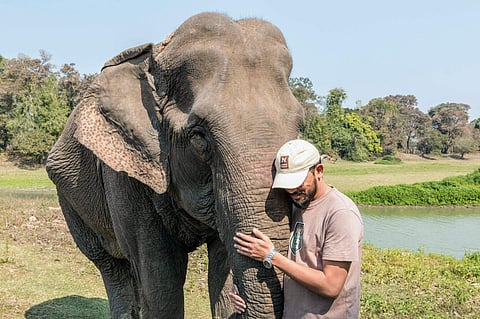

Aditya Chandra Panda likes to look at himself as the watchdog of Odisha's vast and diverse landscape. On an average day, Aditya visits field sites in forests and interacts with both locals and officials of the Forest Department to get information regarding wildlife — to decide on where intervention is needed. He does this day in and day out and hence, has become one of the strongest voices with regards to wildlife conservation and its advocacy in this coastal state. Apart from the Giant Refugees campaign, where conservationists address human-elephant conflict where due to habitat loss, elephants, "would just wander from place to place like refugees," Aditya's style of campaigning is quiet lobbying and advocacy.
Team tiger for the win
We voice the concern of a few environmentalists we have been speaking to and ask Aditya if tigers are really getting more-than-needed attention when it comes to conservation. To which he explains, "Large carnivores are at the very top of their respective ecosystems and in most of India they happen to be tigers. Large carnivores are the best indicators of the health of an ecosystem. So when you save the tiger, you save what it preys on, the habitat of the prey and so on, invariably conserving the whole ecosystem. Large carnivore conservation is the most holistic way to conserve any ecosystem," the 32-year-old explains.
Aditya Chandra Panda, Conservationist | (Pic: Aditya Chandra Panda)
Talking about increasing awareness around conservation and Climate Change, Aditya promptly says that it is a case of, "too little, too late." And it is true — Odisha, after all — was the recipient of one of the biggest blows that Climate Change delivered in recent times in the form of Cyclone Fani. Only under 5 per cent of India's land area is occupied by protected areas for wildlife— now compare that to the US's 15 per cent or Bhutan’s 43 per cent, he implores. "Until environment conservation becomes a political issue, an election issue, we cannot say that there is enough awareness. It continues to be seen as an upper-middle class and high-class concern," he says point blankly.
In search of light
Is there any silver lining at all, we ask Aditya. He says, "Yes, India’s strong foundation of wildlife conservation legislation. They have safeguarded our wildlife so far although the current government is trying to dilute it to benefit industries and infrastructure so it's really hard to find a positive side," he says rather sadly. But he does strongly believe in the conservation movement in India, which he terms as "small but dedicated and powerful" and also commends the few politicians and the many officials of the Forest Department who have stood up for wildlife conservation against impossible odds.
We see hope in youngsters like Aditya, who do their work day in and day out so that tomorrow, the silver lining in the dark cloud.
Point of concern
According to Aditya, these are the four issues which concern Odisha today:
- Forest Department's refusal to acknowledge the dire state of tigers in Odisha. “For several years our State Forest Department deluded the public and itself that all was well with the state’s tigers while the All India Tiger Estimate, conservationists and every voice of reason stated otherwise. This caused irreparable damage. Fortunately, this attitude seems to be changing now," he says
- Complete mismanagement of the state's protected areas. Odisha has 19 wildlife sanctuaries, one national park and two and a half tiger reserves, "I say two and a half because though Sunabeda was given the approval of the centre in 2008 the state is yet to issue a final notification," he says. Of the two tiger reserves, "Simlipal while still struggling has been under capable, dedicated managers since 2009 but Satkosia has seen the near local extinction of tigers," he shares
- The rampant manner in which wild pigs and deer, which are the prey base of the big cats, are poached is sad. "This is seen as a lesser crime by the public and foresters but is the single largest reason behind tiger decline," he says
- Human-wildlife conflict is getting intense in the state, "especially human-elephant conflict. Every other day we see news of elephants and people being killed because of wildlife loss," he rues.
Some of his shots:
On point
The wildlife legislations which are keeping India's wildlife and wilderness safe:
- Wildlife Protection Act, 1972: This act is for the protection of wildlife and plant species
- Project Tiger, 1973: The tiger conservation programme started during Indira Gandhi's tenure
- Forest Conservation Act, 1980: For the conservation of forests
- Indian Forest Act, 1927
For more on him, check out twitter.com/AdityaPanda
